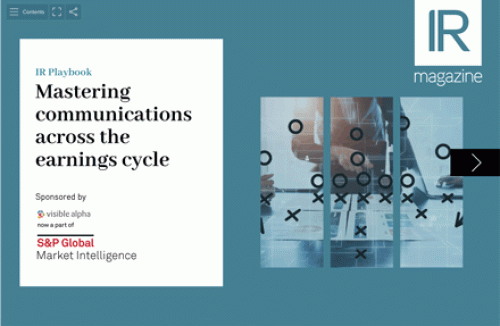A new study looks at how guidance practices and attitudes have shifted over the last decade
‒ The bigger they are, the more they guide
‒ Naked earnings-per-share (EPS) guidance turns people off
‒ Changing guidance used to be a capital offence; now it’s a parking ticket
These are three of the most important, and most unexpected, findings of our recently completed study of the guidance practices of the 1,500 companies in the three S&P stock indexes (large- cap 500, mid-cap 400, small-cap 600). We will go into detail on this in a moment; first, what we set out to do:
‒ Debates about earnings guidance date back a quarter-century. The basic arguments for and against haven’t changed much. Periodic surveys of guidance practices mostly allow self-selected participants to describe preferred disclosures. But these surveys leave central questions unanswered: what do investors actually hear? And what effect does that have on investors’ behavior and on the metrics that matter most to issuers?
‒ Databases now rule investor research. Investors steered us to the guidance that non-shareholders see: what shows up on their preferred digital service. This excludes company-specific or industry-specific metrics, non-numeric characterizations and CEO body language. We figured: if your guidance doesn’t reach the databases, you’re basically preaching to the choir.
‒ We did this once before. A lot has changed: 10 years ago, looking for the same sorts of answers, we manually surveyed the guidance practices of the 400 members of the S&P mid-cap index. The conclusions then were clear; the conclusions today are just as clear, but very different (for quality control, we repeated the manual survey of the mid-caps even while digitally examining the larger 1,500-company sample).
These are the three biggest surprises:
‒ Surprise 1: big companies do the most guidance. The vast majority of our 1,500-company sample gives standard numeric guidance (the kind algorithms pick up) about something, even if it’s only tax rate or capex. But EPS guidance is the nugget most sought. Ten years ago, the smaller companies were the most free with their EPS expectations; they said they did it to attract more sell-side coverage. Today, two thirds of the large caps give numeric EPS guidance, but only two fifths of the small caps do. Why the disparity? Two guesses: big companies are more predictable, and guidance can mute some of the algorithmic volatility to which big firms are subject.
‒ Surprise 2: there’s good EPS guidance and there’s bad EPS guidance. The theory, for many years, was that giving guidance helped (or hurt) the P/E multiple investors applied to a company’s past and expected results. We couldn’t figure out why so many EPS-guiders had P/Es well above their peers or the broad market, while so many others were well below – until we looked at what other guidance was provided. Then it became clear: companies that give naked EPS guidance (no other standard numeric metrics) trade at P/Es markedly below the companies that give no guidance at all. But companies that support their EPS guidance with other key metrics trade at P/Es statistically significantly higher than the no-guidance group. What metrics are these? Any three of these four: revenues, margin, EBITDA and/or free cash flow. No other variable moves the P/E needle.
‒ Surprise 3: changing guidance is no longer a big deal. Back before the financial crisis, changing guidance (or, even worse, missing it without warning) could put companies in the penalty box for a year or more. Repeated misses were known to cost management jobs. Today, just about everybody who gives guidance changes it from time to time. Most often, raising guidance means a higher share price and/or P/E, while lower guidance means the reverse. But much more often than we expected, raising guidance correlates to lower valuations, and trimming guidance correlates to higher valuations. A simplistic explanation is that the market saw the change coming and built it into valuation preannouncement. A more nuanced explanation is that guidance, however thorough, is only one element of valuation, and that rational investors and algorithms may have differing reactions to the same piece of news.
There is no one-size-fits-all solution to the earnings guidance question. But these surprises, more than most of our other findings, suggest it’s time for companies to take a fresh look at long-standing guidance strategies and practices. Some may need a bit of tinkering; others, a substantial rethink.
James MacGregor is vice chairman and a co-founder of Abernathy MacGregor, one of the world’s leading corporate, strategic and financial communications consultancies.










